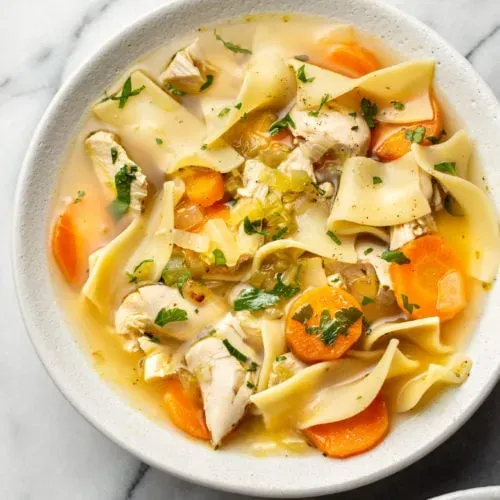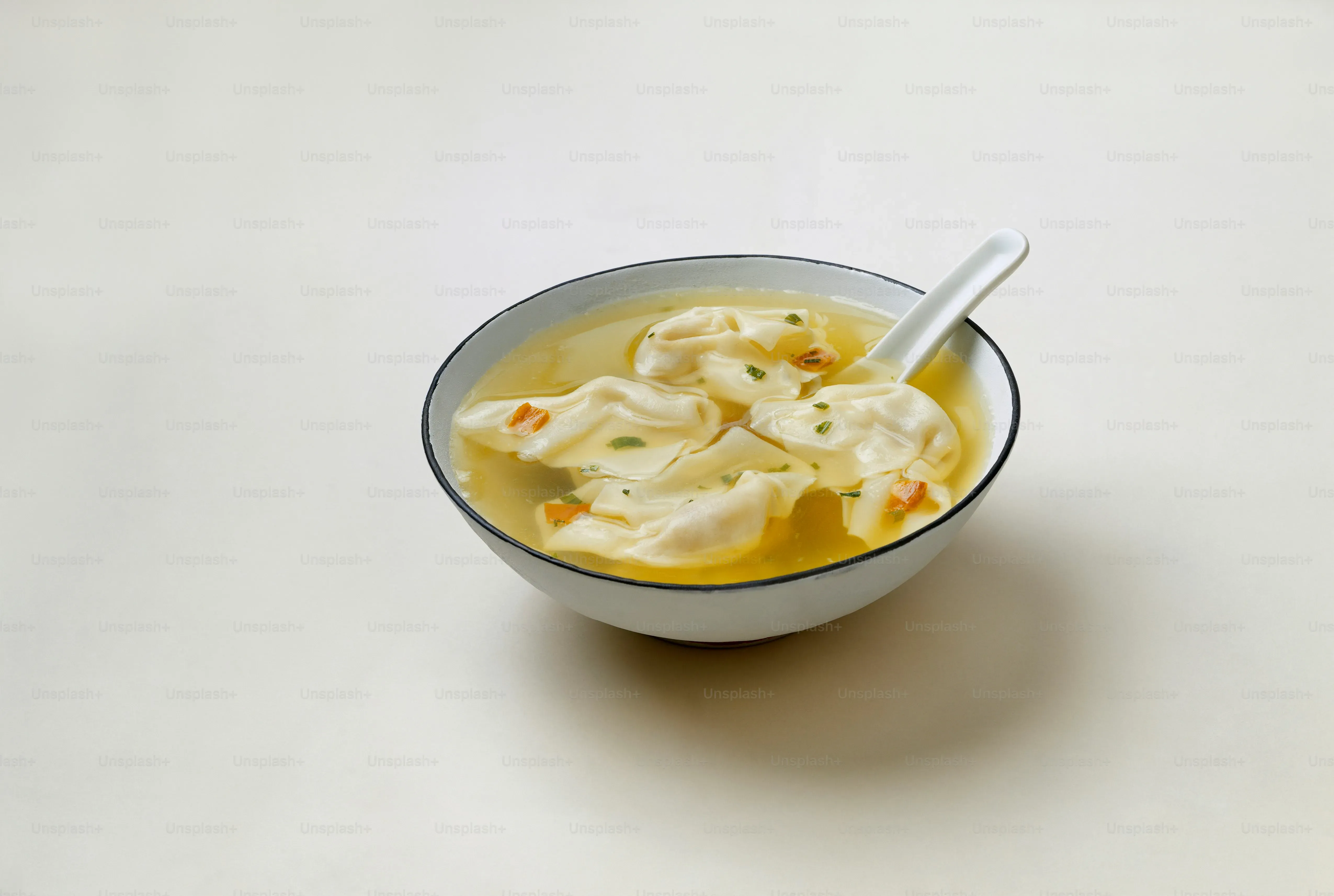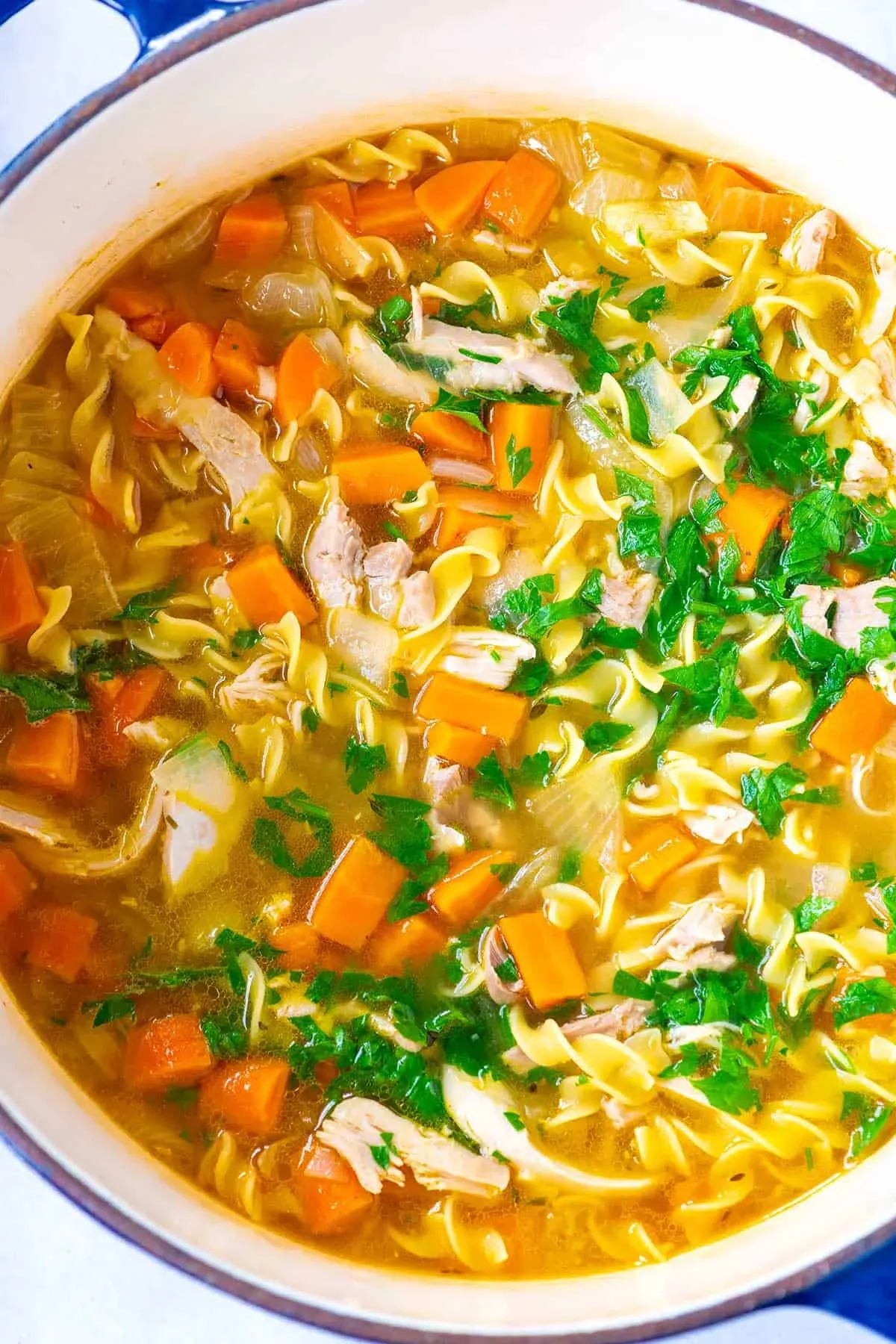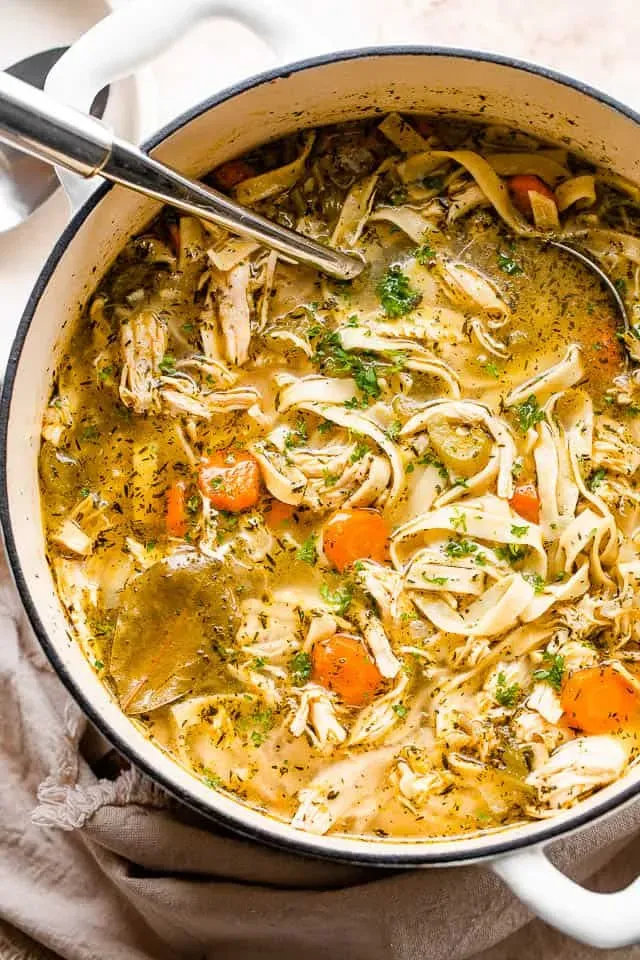Table of Contents
Let's be honest, sometimes you just need a bowl of comfort. Something warm, something familiar, something that whispers, "Everything's going to be okay," even if it's just for the next ten minutes. Chicken noodle soup is that friend. But maybe you've heard you need a whole chicken, bones and all, to get that classic flavor. Or maybe you just want something *easy* that doesn't take all day. Forget the fuss. We're cutting straight to the good stuff with a straightforward chicken noodle soup recipe using chicken breast.
Starting Right: Why Chicken Breast for Your Soup

Starting Right: Why Chicken Breast for Your Soup
The Need for Speed (and Less Mess)
let's cut to the chase. You're hungry, maybe feeling a little under the weather, or just craving that classic comfort. Messing around with a whole chicken, boiling it down, dealing with bones and skin? That's a project. Using chicken breast for your chicken noodle soup recipe? That's efficiency. It cooks fast, it's easy to handle, and you don't end up with a greasy mess to skim. It's the weeknight hero of soup proteins.
Think about it: you can poach a chicken breast in about 15-20 minutes. Shred it, cube it, whatever you like. It integrates cleanly into the soup without leaving behind stray bits of cartilage or bone. If time is tight, or you just can't be bothered with butchery, chicken breast is your direct line to soup satisfaction.
Flavor Myths and How to Beat Them
Now, I know what some soup purists are thinking: "But the bones! That's where the flavor is!" And yes, bones *do* add depth and body to a broth. Nobody's arguing that a slow-simmered bone broth isn't a beautiful thing. But are you making bone broth, or are you making chicken noodle soup for dinner tonight? Most people aren't running a commercial soup kitchen. For a home cook making a chicken noodle soup recipe using chicken breast, you can absolutely achieve a flavorful result.
The trick isn't magic; it's just smart cooking. You build flavor with your aromatics – the onions, carrots, celery – and a good quality stock. You can enhance it further with herbs like thyme or bay leaves. The chicken breast itself absorbs flavor from the broth as it cooks. So while you might miss that specific gelatinous richness from bones, you gain speed and simplicity without sacrificing a genuinely good, comforting bowl.
So, does using chicken breast mean your soup will be bland?
- Not if you use good quality broth.
- Not if you properly sauté your vegetables.
- Not if you remember to season!
- Not if you add herbs and maybe a touch of garlic.
Texture and Integration
Beyond convenience and flavor building, chicken breast offers a specific texture in soup. It's lean, it shreds or cubes neatly, and it doesn't add excess fat. This keeps your soup feeling lighter, which can be a plus, especially if you're not feeling 100%. It also means the chicken pieces are distinct and easy to eat with a spoon.
Using chicken breast in your chicken noodle soup recipe means the protein integrates smoothly with the noodles and vegetables. There's no gristle or chewy skin to contend with. It's just clean, tender pieces of chicken ready to soak up that savory broth. It's a practical choice for a practical meal.
The Easy Chicken Noodle Soup Recipe Using Chicken Breast

The Easy Chicken Noodle Soup Recipe Using Chicken Breast
Putting It All Together: Your Go-To Method
Alright, enough talk about *why* chicken breast works. Let's actually make this soup. The beauty of The Easy Chicken Noodle Soup Recipe Using Chicken Breast is its simplicity. You'll start with your base: a little oil or butter in a pot, heating up. Then, you add your classic mirepoix – chopped onion, carrots, and celery. Don't rush this part; cooking these down until they're slightly softened and the onion is translucent builds a foundational layer of flavor that's crucial, especially when you're not relying on bones for richness. This simple step is where the magic starts for your effortless chicken noodle soup.
Making Your Chicken Noodle Soup Recipe Using Chicken Breast Even Better

Making Your Chicken Noodle Soup Recipe Using Chicken Breast Even Better
Don't Be Shy with Aromatics and Herbs
Look, using chicken breast is about speed and convenience, but that doesn't mean your soup has to taste like disappointment. The secret to a flavorful chicken noodle soup recipe using chicken breast lies heavily in the base. After you've sautéed your mirepoix (onion, carrots, celery) until they're fragrant and just starting to soften – seriously, give this step time, don't just blast them – it's time to bring in the big guns. Think garlic. Minced garlic added in the last minute of sautéing before you add liquid makes a world of difference. And herbs? Fresh dill, parsley, or a sprig of thyme thrown in with the broth infuses a bright, earthy note that elevates the whole pot. Dried herbs work too, but fresh is king here. Don't be afraid to add a bay leaf either; just remember to pull it out before serving.
Boost That Broth Quality (It Matters!)
Since you're not getting deep, bone-rich flavor from the chicken breast itself, the quality of your broth is paramount for a truly satisfying chicken noodle soup recipe using chicken breast. Using plain water is a culinary crime in this context. Opt for a good quality store-bought chicken stock or broth. Low sodium is often a good idea so you can control the seasoning yourself. If you happen to have some homemade stock stashed away, even better. Adding a touch of something acidic right at the end, like a squeeze of lemon juice or a splash of white wine vinegar, can brighten up the flavors remarkably. It sounds weird, but trust me, it works. It cuts through any richness and makes the whole soup taste fresher.
- Flavor Boosters for Your Soup:
- Freshly minced garlic (sautéed)
- Bay leaf (remove before serving)
- Sprigs of fresh thyme or rosemary
- Chopped fresh dill or parsley (stir in at the end)
- A pinch of dried or fresh ginger
- A squeeze of lemon juice or splash of vinegar (right before serving)
- A dash of soy sauce or fish sauce (adds umami depth, use sparingly)
Timing is Everything, Especially for Noodles and Chicken
Nobody wants mushy noodles or tough, dry chicken in their chicken noodle soup recipe using chicken breast. Getting the timing right is crucial. Add your noodles according to the package directions, usually simmering for 8-10 minutes. Don't overcook them in the soup itself, or they'll absorb too much liquid and turn into a starchy blob. As for the chicken breast, if you're poaching it directly in the soup, add it early enough to cook through but not so early that it sits there boiling into submission. Poaching it separately and adding it shredded or cubed towards the end, right before the noodles are done, gives you maximum control over its texture. It stays tender and absorbs the broth without becoming stringy or dry. It's a small step that makes a big difference in the final bowl.
Ingredient Swaps and Twists for Your Chicken Noodle Soup

Ingredient Swaps and Twists for Your Chicken Noodle Soup
Mixing Up Your Veggies and Noodles
So, you've got the basic chicken noodle soup recipe using chicken breast down, but maybe you're staring at your fridge and realize you're out of celery. Or perhaps you just hate celery (it happens). No sweat. This recipe is super flexible. Carrots and onions are pretty standard, but you can absolutely toss in other vegetables. Got some zucchini? Dice it up. A lonely bell pepper? Chop it. Peas or corn? Throw them in towards the end. Spinach? Wilt it in just before serving. The point is, use what you have or what you like. Don't feel tied to the holy trinity of mirepoix if your pantry is telling a different story. The same goes for noodles. Egg noodles are classic for this chicken noodle soup recipe, but thin spaghetti broken into pieces, macaroni, or even rice (though then it's chicken rice soup, obviously) can work. Just adjust the cooking time based on the pasta you choose.
- Vegetable Swap Ideas:
- Zucchini (diced)
- Bell peppers (any color, diced)
- Peas (frozen or fresh)
- Corn (frozen or canned)
- Spinach (fresh, wilted in at the end)
- Green beans (trimmed and snapped)
Different Chicken, Same Comfort Goal
the core idea here is a chicken noodle soup recipe using chicken breast because it's easy. But what if you have *already cooked* chicken breast? Even easier. Leftover roast chicken? Shredded rotisserie chicken? Perfect. Just skip the step where you cook the raw chicken breast. Add your pre-cooked chicken towards the end of the soup's simmer, maybe five minutes before the noodles are done. This just warms it through and lets it soak up some of that lovely broth flavor without drying out. It's the ultimate shortcut to getting that comforting bowl even faster. It's still a chicken noodle soup, just with a head start on the protein.
Spice It Up (or Add Something Unexpected)
Feeling adventurous with your chicken noodle soup recipe using chicken breast? You don't have to stick to just salt and pepper. A pinch of dried thyme or a bay leaf added while the broth simmers adds a nice background note. For a little kick, a tiny pinch of red pepper flakes can wake things up. A controversial but sometimes brilliant move is a dash of soy sauce or fish sauce; it adds a deep umami flavor without making the soup taste distinctly Asian. Just a tiny bit, seriously. And as mentioned before, a squeeze of lemon juice right before serving brightens everything up beautifully. Don't knock it till you try it. These little tweaks can take your simple chicken breast soup from good to surprisingly great.
Flavor Boosters Beyond the Basics | Why It Works |
|---|---|
Red Pepper Flakes | Adds a subtle warmth/kick |
Soy Sauce or Fish Sauce | Adds savory umami depth (use sparingly!) |
Lemon Juice | Brightens and balances flavors |
Fresh Ginger (grated) | Adds a warm, slightly spicy note |
Keeping Your Chicken Noodle Soup Delicious: Storage Tips

Keeping Your Chicken Noodle Soup Delicious: Storage Tips
Chilling Out: Refrigeration Basics
So you've whipped up a glorious batch of chicken noodle soup recipe using chicken breast. Great job. Now, unless you plan to eat the whole pot in one sitting (no judgment, but maybe pace yourself), you'll need to store it. First things first: cool it down properly. Don't just shove a steaming hot pot into the fridge; that's a fast track to bacteria growth and warming up everything else in there. Let it sit at room temperature for a bit until it's no longer piping hot, then transfer it to airtight containers. Glass containers are great because they don't hold onto odors. Plastic works too, just make sure the lids seal tight. Your soup will last a solid 3-4 days in the refrigerator. After that? Things get dicey.
Freezing for Future Comfort
Got more soup than you can eat in four days? The freezer is your friend. Freezing chicken noodle soup recipe using chicken breast is absolutely doable, but here's a pro tip: if you know you're freezing a portion, consider undercooking the noodles slightly, or even better, cooking them separately and adding them right before serving after thawing. Noodles turn mushy in the freezer. Freezing the broth with the chicken and veggies, then adding freshly cooked noodles later, gives you a much better texture upon reheating. Again, use airtight, freezer-safe containers or heavy-duty freezer bags, leaving a little headspace for expansion. Properly frozen, this soup keeps for about 2-3 months. Beyond that, flavor can start to fade and freezer burn becomes a real threat.
Best Practices for Storing Your Soup:
- Cool soup quickly before refrigerating or freezing.
- Use airtight containers to prevent spoilage and odor transfer.
- Refrigerate for up to 4 days.
- Freeze for up to 3 months for best quality.
- Consider freezing soup base and cooking noodles fresh when reheating.
- Label and date your containers so you know what's what and how long it's been there.
Wrapping Up Your Comfort Bowl
So there you have it. Making a genuinely satisfying chicken noodle soup doesn't require a weekend commitment or a deep dive into obscure poultry parts. Using chicken breast gets you to that warm, comforting bowl faster and with less fuss. It’s proof that sometimes the simplest path leads directly to exactly what you need. No need for culinary acrobatics, just good ingredients treated right. Now go make some soup. You've earned that moment of quiet comfort.
